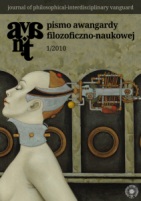“How it is” Balka’s Black Box and the strengths and weaknesses of the sensorimotor solution: An Introduction
“How it is” Balka’s Black Box and the strengths and weaknesses of the sensorimotor solution: An Introduction
Author(s): Victoria StoneSubject(s): Fine Arts / Performing Arts
Published by: Ośrodek Badań Filozoficznych
Summary/Abstract: “How should I move forward?” you might ask yourself, as you stand at the threshold confronted by the darkness ahead. Many of us learn from an early age to fear the unfamiliar or the unknown. If the unknown is without light, it can become unjustifiably terrifying. How you approach the unknown is unique, as your first encounter with anything can only really be as an individual. Staring ahead into the black void of “How it is” you may wonder whether to move ahead at all. “How it is” simultaneously embodies the unknown and the familiar. The darkness contained in the structure mimics both the architecture of the turbine hall and a shipping container. “It’s fine!” you reassure yourself. What can possibly be inside? “How it is” is only complete when you, the viewer, enter the black hole”1. The work by Miroslaw Balka, a Polish artist, is a windowless room 13 m high and 30 m long that is designed to create absolute darkness inside. In the Turbine Hall of the TATE Modern, one walks up a ramp into a container like room.
Journal: AVANT. Pismo Awangardy Filozoficzno-Naukowej
- Issue Year: 2010
- Issue No: 1
- Page Range: 307-316
- Page Count: 10
- Language: English

